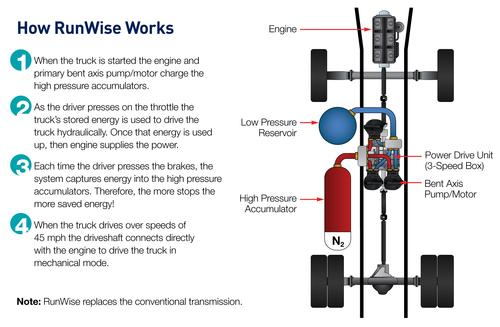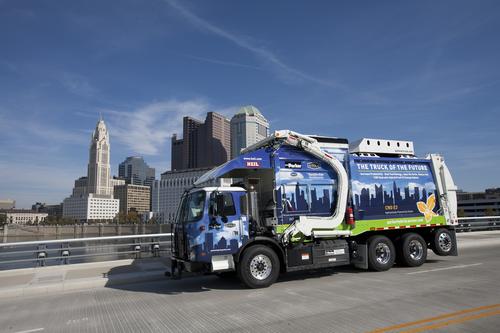Why EPA Standard Could Push Hydraulic Hybrid Powertrains Forward
November 19, 2015

The long-overlooked hydraulic hybrid may finally be on the verge of making gains in the heavy-duty truck market, thanks to newly proposed fuel economy standards from the EPA.
The proposed standards, which call for dramatic reductions in fuel consumption, could pave the way for newer, more innovative powertrain solutions. "People are going to have to start thinking outside the box," noted Shane Terblanche, general manager of hybrid drive systems for Parker Hannifin Corp. "They'll have to look at the entire powertrain."

Indeed, that's what the hydraulic hybrid does. Instead of putting the onus on the engine to squeeze more energy from less fuel, it shifts the efficiency burden to the hybrid transmission. It accomplishes that, not with a big lithium-ion battery, but with a hydraulic pump-motor, reservoir, and accumulator, in combination with the internal combustion engine. During operation, it stores energy in the accumulator by using hydraulic fluid to compress a gas, usually nitrogen. The stored nitrogen in the accumulator then helps launch the vehicle. The big advantage is that this technique is far more efficient than electric hybrids at capturing braking energy, and therefore can give a boost to vehicles that stop and start frequently. Hence, the natural application of it in garbage trucks, delivery trucks, and buses.
Parker Hannifin, which makes a hydraulic hybrid system called RunWise, claims it can reduce emissions and fuel consumption by up to 50% in urban, stop-start-type applications. The increased efficiency makes it possible for the hydraulic hybrid to easily meet the new EPA standard, which calls for 16% to 24% fuel reductions in large diesel-powered vehicles manufactured from 2021 to 2027. "When a chassis OEM uses our system, they're immediately compliant," Terblanche told us.

For truck and bus manufacturers, the question is whether it's possible to make the same efficiency gains solely through engine improvements. Terblanche said many industry experts believe that would be difficult. "They've already done direct injection, high-pressure common rail, full electronic control, engine-off and zero-fuel coasting," he said. "It's our opinion that without significant research and development, engine manufacturers would struggle to go much further."
To be sure, neither approach is cheap. Up to now, hydraulic hybrids haven't enjoyed widespread adoption, in part because of EPA regulations that burden the truck and bus OEMs with additional validation and certification. The regulations apply to hydraulic hybrid transmissions, but not to conventional transmissions. So even as the new fuel consumption standards provide a boost for hydraulic hybrids, the certification regulations call for OEMs to make a bigger investment up front.
READ MORE ARTICLES ON HYDRAULIC HYBRIDS::
Still, the long-term forecast is for greater adoption. A 2013 study authored by Navigant Research predicted minimum sales of 10,000 hydraulic hybrids per year by 2025, with maximum sales possibly reaching as high as 60,000. "Everyone we talked to said the technology is reliable, offers good performance, and costs a lot less than electric hybrid technology," David Alexander, the study's author, told Design News in 2013. "You get the benefits when you're starting and stopping a lot, so it's good for garbage trucks, delivery trucks, and city buses."
Parker engineers say the cost of battery-based hybrid technology, along with its general lack of success in big trucks, is motivating more OEMs to consider hydraulics. Parker now has 68 heavy duty trucks in Miami and 32 in Orlando using the technology, along with more in California, Washington, Colorado, and Texas. The fluid power giant is also working with OEMs in South America, Australia, India, Mexico, and the UK.
"It's still a rather small group of customers and we need to increase the adoption rate," Terblanche said. "But there's a lot of momentum. People are realizing that it's a simple technology and it works."
Senior technical editor Chuck Murray has been writing about technology for 31 years. He joined Design News in 1987, and has covered electronics, automation, fluid power, and autos.
Like reading Design News? Then have our content delivered to your inbox every day by registering with DesignNews.com and signing up for Design News Daily plus our other e-newsletters. Register here!

Design engineers and professionals, the West Coast's most important design, innovation, and manufacturing event, Pacific Design & Manufacturing, is taking place in Anaheim, Feb. 9-11, 2016. A Design News event, Pacific Design & Manufacturing is your chance to meet qualified suppliers, get hands-on access to the latest technologies, be informed from a world-class conference program, and expand your network. (You might even meet a Design News editor.) Learn more about Pacific Design & Manufacturing here.
About the Author(s)
You May Also Like

.jpg?width=300&auto=webp&quality=80&disable=upscale)

